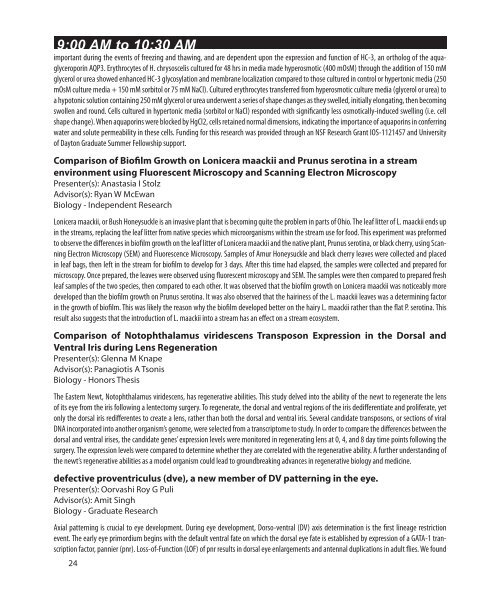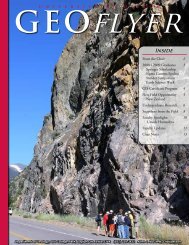Stander Symposium abstract book - University of Dayton
Stander Symposium abstract book - University of Dayton
Stander Symposium abstract book - University of Dayton
Create successful ePaper yourself
Turn your PDF publications into a flip-book with our unique Google optimized e-Paper software.
9:00 AM to 10:30 AM<br />
important during the events <strong>of</strong> freezing and thawing, and are dependent upon the expression and function <strong>of</strong> HC-3, an ortholog <strong>of</strong> the aquaglyceroporin<br />
AQP3. Erythrocytes <strong>of</strong> H. chrysoscelis cultured for 48 hrs in media made hyperosmotic (400 mOsM) through the addition <strong>of</strong> 150 mM<br />
glycerol or urea showed enhanced HC-3 glycosylation and membrane localization compared to those cultured in control or hypertonic media (250<br />
mOsM culture media + 150 mM sorbitol or 75 mM NaCl). Cultured erythrocytes transferred from hyperosmotic culture media (glycerol or urea) to<br />
a hypotonic solution containing 250 mM glycerol or urea underwent a series <strong>of</strong> shape changes as they swelled, initially elongating, then becoming<br />
swollen and round. Cells cultured in hypertonic media (sorbitol or NaCl) responded with significantly less osmotically-induced swelling (i.e. cell<br />
shape change). When aquaporins were blocked by HgCl2, cells retained normal dimensions, indicating the importance <strong>of</strong> aquaporins in conferring<br />
water and solute permeability in these cells. Funding for this research was provided through an NSF Research Grant IOS-1121457 and <strong>University</strong><br />
<strong>of</strong> <strong>Dayton</strong> Graduate Summer Fellowship support.<br />
Comparison <strong>of</strong> Bi<strong>of</strong>ilm Growth on Lonicera maackii and Prunus serotina in a stream<br />
environment using Fluorescent Microscopy and Scanning Electron Microscopy<br />
Presenter(s): Anastasia I Stolz<br />
Advisor(s): Ryan W McEwan<br />
Biology - Independent Research<br />
Lonicera maackii, or Bush Honeysuckle is an invasive plant that is becoming quite the problem in parts <strong>of</strong> Ohio. The leaf litter <strong>of</strong> L. maackii ends up<br />
in the streams, replacing the leaf litter from native species which microorganisms within the stream use for food. This experiment was preformed<br />
to observe the differences in bi<strong>of</strong>ilm growth on the leaf litter <strong>of</strong> Lonicera maackii and the native plant, Prunus serotina, or black cherry, using Scanning<br />
Electron Microscopy (SEM) and Fluorescence Microscopy. Samples <strong>of</strong> Amur Honeysuckle and black cherry leaves were collected and placed<br />
in leaf bags, then left in the stream for bi<strong>of</strong>ilm to develop for 3 days. After this time had elapsed, the samples were collected and prepared for<br />
microscopy. Once prepared, the leaves were observed using fluorescent microscopy and SEM. The samples were then compared to prepared fresh<br />
leaf samples <strong>of</strong> the two species, then compared to each other. It was observed that the bi<strong>of</strong>ilm growth on Lonicera maackii was noticeably more<br />
developed than the bi<strong>of</strong>ilm growth on Prunus serotina. It was also observed that the hairiness <strong>of</strong> the L. maackii leaves was a determining factor<br />
in the growth <strong>of</strong> bi<strong>of</strong>ilm. This was likely the reason why the bi<strong>of</strong>ilm developed better on the hairy L. maackii rather than the flat P. serotina. This<br />
result also suggests that the introduction <strong>of</strong> L. maackii into a stream has an effect on a stream ecosystem.<br />
Comparison <strong>of</strong> Notophthalamus viridescens Transposon Expression in the Dorsal and<br />
Ventral Iris during Lens Regeneration<br />
Presenter(s): Glenna M Knape<br />
Advisor(s): Panagiotis A Tsonis<br />
Biology - Honors Thesis<br />
The Eastern Newt, Notophthalamus viridescens, has regenerative abilities. This study delved into the ability <strong>of</strong> the newt to regenerate the lens<br />
<strong>of</strong> its eye from the iris following a lentectomy surgery. To regenerate, the dorsal and ventral regions <strong>of</strong> the iris dedifferentiate and proliferate, yet<br />
only the dorsal iris redifferentes to create a lens, rather than both the dorsal and ventral iris. Several candidate transposons, or sections <strong>of</strong> viral<br />
DNA incorporated into another organism’s genome, were selected from a transcriptome to study. In order to compare the differences between the<br />
dorsal and ventral irises, the candidate genes’ expression levels were monitored in regenerating lens at 0, 4, and 8 day time points following the<br />
surgery. The expression levels were compared to determine whether they are correlated with the regenerative ability. A further understanding <strong>of</strong><br />
the newt’s regenerative abilities as a model organism could lead to groundbreaking advances in regenerative biology and medicine.<br />
defective proventriculus (dve), a new member <strong>of</strong> DV patterning in the eye.<br />
Presenter(s): Oorvashi Roy G Puli<br />
Advisor(s): Amit Singh<br />
Biology - Graduate Research<br />
Axial patterning is crucial to eye development. During eye development, Dorso-ventral (DV) axis determination is the first lineage restriction<br />
event. The early eye primordium begins with the default ventral fate on which the dorsal eye fate is established by expression <strong>of</strong> a GATA-1 transcription<br />
factor, pannier (pnr). Loss-<strong>of</strong>-Function (LOF) <strong>of</strong> pnr results in dorsal eye enlargements and antennal duplications in adult flies. We found<br />
24

















